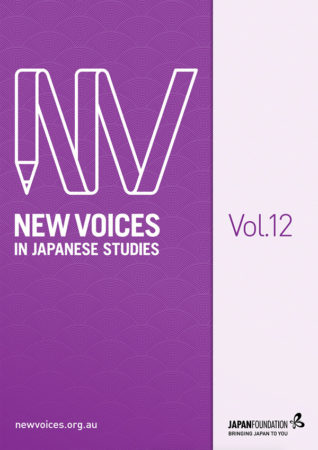
Volume 12
Guest Editor: Dr Alexander Brown,
University of Technology Sydney and Japan Women’s University
Published August, 2020
ISSN 2205-3166
https://doi.org/10.21159/nvjs.12
© The Japan Foundation, Sydney, 2020

This paper explores concessions made by Australian authorities concerning Japanese immigration during the era of the White Australia Policy in the early twentieth century. Australia’s Immigration Restriction Act was introduced in December 1901. As the major piece of legislation in the White Australia Policy, the act made it virtually impossible for non-Europeans to migrate to Australia. However, Japanese people enjoyed a special position among non-Europeans under the White Australia Policy thanks to Japan’s growing international status as a civilised power at the time, as well as its sustained diplomatic pressure on Australia. While the Commonwealth was determined to exclude Japanese permanent settlers, it sought ways to render the policy of exclusion less offensive to the Japanese. In the early 1900s, two minor modifications to the Immigration Restriction Actwere implemented in order to relax the restrictions imposed on Japanese citizens. Moreover, in the application of Commonwealth immigration laws, Japanese people received far more lenient treatment than other non-Europeans and were afforded respect and extra courtesies by Australian officials. Nevertheless, these concessions Australia made to Japanese citizens were minor, and the Commonwealth government maintained its basic policy of excluding Japanese permanent settlers from Australia. This paper shows that, despite continued diplomatic efforts, Japan was fundamentally unable to change pre-war Australia’s basic policy regarding the exclusion of Japanese permanent settlers.
The rising fame of multiethnic and multiracial or mixed’ celebrities in Japan, such as tennisplayer Naomi Osaka, has brought into focus the roles of Japan’s Nationality Law and understandings of nationality and citizenship in shaping identity. According to Article 14 ofJapan’s Nationality Law, persons holding multiple nationalities must choose to forfeit all but one before the age of 22. In this article I aim to address how multiethnic and multiracial youths of Japanese descent in Australia are approaching the ambiguities surrounding their citizenship and nationality rights. To do so I will closely examine to what extent theNationality Law affects their future decisions and identities by drawing upon evidence from in-depth interviews I conducted with mixed Japanese youth who are the child of oneJapanese parent and one non-Japanese parent and live in Australia. Using Pierre Bourdieu’s theory of cultural capital, I argue that mixed Japanese youth in Australia perceive citizenshipless as an agent of identity and more as an index of socioeconomic opportunity. My findingsdemonstrate that these individuals actively strive to maintain their dual citizenship and strategically align their cultural capital to realise meaningful cross-cultural careers that communicate between Australia, Japan, and their own mixed identities.
The distinctive narrative style exhibited in Japanese author Yasunari Kawabata’s literary works has frequently been associated with the traditional Japanese art of linked-verse poetry (renga). However, the precise compositional nature of these similarities has yet to be thoroughly explored. In this article, I examine two fundamental principles of linked-verse poetry, linking’ (tsukeai) and flow’ (yukiyÅ), and use these as analytical tools to explore the thematic and narrative structure for which Kawabata’s literary technique is renowned. Considering the first chapter of his 1954 novel The Lake (Mizuumi) as a case study, I identify notable correspondences between linked verse and Kawabata’s prose writing in the form of a qualitative mode of progression characterised by a rich use of sensory and emotiveassociation, and a wave-like sense of rhythm between moments of heightened and reduced expressive and affective intensity. This article uses detailed textual analysis to demonstrate a structural basis for comparing Kawabata’s prose with linked verse, which in turn implies that Kawabata’s narrative style is shaped by conscious aesthetic decisions to draw on linked-verseprinciples.
Japanese director Tsutomu Mizushima’s 2012 animated television series, Another, presents a narrative whereby one social group’s refusal to accept an unexpected death triggers an intergenerational curse. This paper takes a close reading of Mizushima’s anime, showing how its narrative contends that the present—and by default the future—is not self-sufficient but instead relies upon understandings of the past. The analysis uses the lens of Jacques Derrida’s theory of hauntology, which opens up a space for discursive accounts of the presence of the past in the present and its influence on the future, and therefore serves as a powerful tool for interrogating questions of war memory. I demonstrate that Anotherexemplifies the use of anime as a critical medium, showing how it uses allegory to explore the motivations and consequences of Japan’s lack of a dominant historical narrative about thewar and the resulting intergenerational effects of this historical consciousness problem. AsJapan continues to debate remilitarisation and the fate of Article 9 in its constitution, it seems particularly apt to revisit Mizushima’s Another, which illustrates the dangers of ignoring the spectre of history.
Literature that explores alternative kawaii (cute’; adorable’) fashion associated with Harajuku, Japan, argues that it is an infantile practice in which practitioners seek to reject adult thoughts, feelings and responsibility through childish mannerisms and dress. These understandings of kawaii fashion, however, are formed without input from practitioners themselves. Drawing upon a case-focused analysis of alternative kawaii fashion practitioners in Harajuku derived from semi-structured interviews, this article seeks to contribute to this discussion from a sociological perspective. The article focusses on decora and fairy kei, two alternative kawaii fashion styles in Harajuku that typically incorporate toys and clothing intended for children, and in doing so blur the boundaries between acceptable attire for children and adults. The article provides an overview of literature on the relationship betweenkawaii fashion and the little girl’ (shōjo) and identifies new possibilities for expanding on current understandings of kawaii. It also seeks to complicate views that equate alternative kawaii fashion practice with childishness by placing the voices of two practitioners in dialogue with scholarly research in this area to date. In doing so, the article advocates for the voices of practitioners to be considered in future scholarship on alternative kawaii fashion with ties to Harajuku.
REVIEWS
